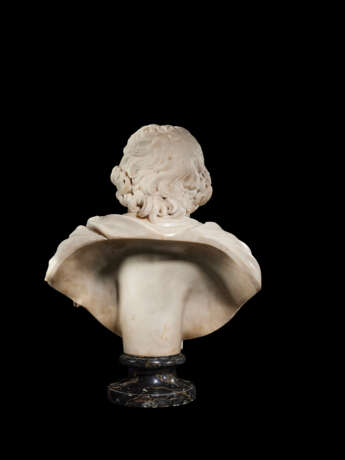ID 1329902
Lot 17 | FRANCIS HARWOOD (CIRCA 1726/1727-1783)
Valeur estimée
€ 100 000 – 150 000
Oliver Cromwell (1599-1658), lord-protecteur d'Angleterre, d'Écosse et d'Irlande
buste en marbre, sur un socle en marble Portor, signé et daté 'F. Harwood Fecit 1759' et titré 'O. CROMWELL' à l'avant
H. 63 cm (24 ¾ in.), L. 57cm (22 ½ in.), H. totale : 75 cm (29 ½ in.)
Provenance
Sir Wyndham Knatchbull-Wyndham, 6th Baronet (1737-1763), Mersham-le-Hatch, Kent ;
Puis par descendance à Lord Brabourne.
Vente anonyme, Christie's, Londres, 15 juillet 1986, lot 73.
Cyril Humphris ;
Sa vente, Sotheby's, New York, 10 janvier 1995, lot 66.
Importante collection privée française.
Literature
A. Tipping, English Home, Period VI, Vol 1, Londres, 1926, p. 124, ill. fig. 189-190.
C. Hussey, English coutry houses, Mid Georgian, 1760-1820, 1955-1958, fig. 83, p.100.
A. Dawson, Portrait sculpture : a catalogue of the British Museum collection, c. 1675-1975, Londres, 1999, pp. 77.
J. Bryant, Thomas Banks, 1735-1805 : Britain's first modern sculptor, Londres, 2005, p. 42.
E. Harris, The Country Houses of Robert Adam : From the Archives of Country Life, Londres, 2007, pp. 66-71, ill. p. 69.
BIBLIOGRAPHIE COMPARATIVE
H. Walpole, Anecdotes of Painting in England, 1763, réédition : Londres, 1871, p. 226.
D. Burlot, “ Le Grand Tour, les collectionneurs et les faux (1715-1736)” in Fabriquer l’antique, Naples, 2012, p. 37.
Further details
A MARBLE BUST OF OLIVER CROMWELL (1599-1658), LORD PROTECTOR OF ENGLAND, SCOTLAND AND IRELAND, FRANCIS HARWOOD (CIRCA 1726/1727-1783)
Having arrived in Rome in 1752, the English sculptor, Francis Harwood, moved to Florence the following year to work with Giovanni Battista Piamontini. When the master died in 1762, he took over the running of his workshop.
Harwood is known for his copies of ancient works created for British collectors influenced by the Grand Tour who wanted to ‘decorate their newly built country houses’ (D. Burlot, ‘Le Grand Tour, les collectionneurs et les faux (1715-1736)’ in Fabriquer l'antique, Naples, 2012, p. 37). As the present composition is the invention of the sculptor, this bust is an exception in his oeuvre. Probably created in 1757, Harwood was certainly inspired by a terracotta head of the Lord Protector now in the Bargello. The model is believed to have been made from his death mask and appears to be in accordance with to the precepts he gave to his portraitists, Peter Lely and Samuel Cooper : ‘Mr Lely, I desire you would use all your skill to paint my picture truly like me, and not flatter me at all; but remark all these roughnesses, pimples, warts, and everything as you see me; otherwise I will never pay a farthing for it’ (H. Walpole, Anecdotes of Painting in England, 1763). Harwood succeeded in representing the Cromwell's personality : his sculpture highlights the moral qualities and the dignity of his model.
The emblematic politician of the 17th century Oliver Cromwell (1599-1658) became an important source of inspiration for many artists. In the 18th century, he was often represented by sculptors : Michael Rysback produced a bust in 1757 (terracotta, London, National Maritime Museum, inv. SCU0014), John Wilton made another bust in 1762 (marble, London, Victoria and Albert Museum, inv. A.72-1965). Francis Harwood created four portraits: one was sold at Sotheby's, London, 2 July 1997, lot 264, a second is in the Ashmolean Museum in Oxford, inv. WA1920.2. However, only two of the group are signed and dated: one from 1757 was sold on the 4th December 2018 at Christie's London (lot 69) and the other made in 1759 is our present bust.
In 1761, Harwood met the young architect James Adam in Italy, where he had relocated in order to provide his brother Robert, back home in Britain, with Italian works. It was also a way for them to offer to their clients complete projects including plans, construction and decoration. The brothers were to become key patrons to the Harwood and often commissioned works directly from sculptors for the houses they designed.
Given that Robert Adam designed the house that the present bust was originally intended for (Mersham le Hatch in Kent, commissioned Sir Wyndham Knatchbull-Wyndham, 6th Baronet (1737-1763)) it is likely he could have commissioned it directly from Harwood. This is all the more probable given the brothers are known to have commissioned a sculpture of Apollo from Harwood for the dining room at Syon House.
| Adresse de l'enchère |
CHRISTIE'S 9 Avenue Matignon 75008 Paris France | ||||||||||||||
|---|---|---|---|---|---|---|---|---|---|---|---|---|---|---|---|
| Aperçu |
| ||||||||||||||
| Téléphone | +33 (0)1 40 76 85 85 | ||||||||||||||
| Fax | +33 (0)1 40 76 85 86 | ||||||||||||||
| Conditions d'utilisation | Conditions d'utilisation | ||||||||||||||
| transport |
Service postal Service de messagerie ramassage par vous-même | ||||||||||||||
| Modes de paiement |
Virement bancaire | ||||||||||||||
| Heures d'ouverture | Heures d'ouverture
|










